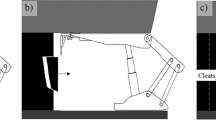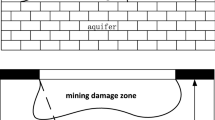Abstract
Large scale roof strata caving that occurs during coal extraction can irreversibly damage floor strata and result in riskier mining operations. Four research models incorporating floor water pressure were assessed for floor strata failure, using eight methods and two classification systems. A connection between floor strata failure and the coefficient of impact risk was developed. The derived equations represent a potentially effective method for providing a preliminary assessment of the risks associated with floor strata failure due to caving. A classification system of floor failure potential can be constructed to minimize risks during mining.
Zusammenfassung
Das Herabbrechen des Hangenden während des Kohleabbaus kann zu einer irreversiblen Zerstörung des Liegenden und zu einer Gefährdung des Bergbaubetriebes führen. Vier Modelle, die den Liegendwasserdruck berücksichtigen, wurden entwickelt, um den Bruch des Liegenden zu unter-suchen. Dabei wurden acht Methoden und zwei Klassifikationssysteme verwendet. Zwischen dem Bruch des Liegenden und dem Risikokoeffizienten wurde eine Beziehung aufgestellt. Die abgeleiteten Gleichungen stellen eine effektive Methode dar, um eine Vorabschätzung des Liegendbruches auf Grund des Abbaus zu erstellen. Für das Risikos eines Liegendbruchs wurde ein Klassifikationssystem erstellt, um die Gefahr während des Abbaus zu minimieren.
Resumen
El cavado a gran escala que ocurre durante la extracción de carbón puede dañar irreversiblemente la estructura del piso y resultar en un mayor riesgo en las operaciones mineras. Para relevar la falla estructural del piso se utilizaron cuatro modelos que incorporan la presión de agua del piso, con 8 métodos y 2 sistemas de clasificación. Se desarrolló una conexión entre la falla de la estructura del piso y el coeficiente de impacto de riesgo. Las ecuaciones derivadas representan un metodo potencialmente efectivo para ofrecer un relevamiento preliminar de los riesgos asociados con la falla de la estructura del piso debido al cavado. Es posible construir un sistema de clasificiación de potenciales fallas del piso para minimizar los riesgos durante la operación minera.
文章概要
煤炭回采期间大范围顶板冒落能够诱发底板不可逆转破坏并加重回采危险。基于八类方法和两种分类评价了4个包含底板含水层水压的底板破坏模型。建立了底板破坏和风险系数的关系,推导出顶板冒落引起底板破坏的风险评估方程。一种底板破坏分类体系可用以降低回采风险。




Similar content being viewed by others
References
Abbas M, Ferri PH, Mehdi YN (2012) Prediction of the height of destressed zone above the mined panel roof in longwall coal mining. Int J Coal Geol 98:62–72. doi:10.1016/j.coal.2012.04.005
Adler L, Sun MC (1968) Ground control in bedded formations bull 28. Virginia Polytechnic Institute, Blacksburg
Anon (1995) Longwall mining, office of coal, nuclear, electric and alternate fuels. US Department of Energy, Washington, pp 9–10
Bai XQ, Bai HB, Shen ZH (2009) Relative strata impermeability in Ordovician top and risk assessment of water inrush from coal floor in Xinyi coalfield. Chin J Rock Mech Eng 28(2):273–280
Beer FP, Johnston ER (2005) Mechanics of materials, 4th edn. McGraw Hill, New York City
Bilinski A, Konopko W (1973) Criteria for choice and use of powered supports. In: Proceedings of symposium on protection against roof falls, Katowice, Poland, No. IV-1
Brady BHG, Brown ET (2004) Rock mechanics for underground mining, 3rd edn. Chapman & Hall, London
Chugh YP, Missavage RA (1981) Effects of moisture on strata control in coal mines. Eng Geol 17(4):241–255
Diederichs MS, Kaiser PK (1999) Tensile strength and abutment relaxation as failure control mechanisms in underground excavations. Int J Rock Mech Min Sci 36(1):69–96. doi:10.1016/S0148-9062(98)00179-X
Dong DL, Sun WJ, Xi S (2012) Water-inrush assessment using a GIS-based Bayesian network for the 12-2 coal seam of the Kailuan Donghuantuo coal mine in China. Mine Water Environ 31(2):138–146
Du Bois C (2009) Comprehensive design methodology for coal mining under competent sandstone roof. MS Thesis, University of British Columbia, Canada
Evans WH (1941) The strength of undermined strata. Trans Inst Min Metall 50:475–532
Fayol M (1885) Sur les movements de terrain provoques par l’exploitation des mines. Bull Soc Indust Min 14:818
Gere JM, Goodno BJ (2011) Mechanics of materials, 7th edn. Cengage Learning, Stamford, pp 153–162
Hanna K, Conover D, Haramy K (1991) Coal mine entry intersection behavior study. US Bureau of Mines, Washington DC
Hu WY, Yin SX (2010) Dynamic mechanism of water inrush from floor of mining face. Chin J Rock Mech Eng 29(S-1):3344–3349
Huang Z, Jiang ZQ, Zhu SY (2014) Characterizing the hydraulic conductivity of rock formations between deep coal and aquifers using injection tests. Int J Rock Mech Min Sci 71:12–18. doi:10.1016/j.ijrmms.2014.06.017
Jin ZM (2006) Theory and technology of top coal caving mining. China Coal Industry Publishing House, Beijing
Kuznetsov ST, Pekarskii DG, Korovkin VT (1973) Determining the normal stresses in a uniform bent beam cantilever. Sov Min Sci 9(5):478–482
Li BY (1999) The “Lower three zones” theory on preventing floor water inrush and its development together with application. J Shandong I Min Technol 4:11–18 (in Chinese)
Li BY, Shen GH, Jing ZG, Gao H (1988) The theory and practice of preventing water inrush in mining working face. Saf Coal Min 5:47–48 (in Chinese)
Liu HH (2014) Fundamental concept of indication layer in coal floor mining under water pressure. China University of Mining and Technology Press, Xuzhou, pp 59–63
Majumdar S (1986) The support requirement at a longwall face—a bending moment approach. In: Proceedings of 27th US symposium rock mechanics: key to energy production, University of Alabama, Tuscaloosa, AL, USA, pp 325–332
Manteghi H, Shahriar K, Torabi R (2012) Numerical modelling for estimation of first weighting distance in longwall coal mining—a case study. In: Proceedings of 12th coal operators’ conference, University of Wollongong and the Australasian Institute of Mining and Metallurgy, pp 60–68
Mojtaba R, Abdolreza YC, Siamak HY (2013) A novel fuzzy inference system for predicting roof fall rate in underground coal mines. Saf Sci 55:26–33. doi:10.1016/j.ssci.2012.11.008
Mueller AR (2010) An analysis of current intersection support and falls in united states coal mines and recommendations to improve safety. MS Thesis, Southern Illinois University Carbondale, USA
Obert L, Duvall WI (1967) Rock mechanics and the design of structures in rock. Wiley, New York
Pawlowicz K (1967) Classification of rock cavability of coal measure strata in Upper Silesia coalfield. Prace GIG, Komunikat, Katowice, No. 429 (in Polish)
Peng SS (2008) Coal mine ground control, 3rd edn. West Virginia University, Department of Mineral Engineering, Morgantown
Peng SS, Chiang HS (1982) Roof stability in longwall coal faces. In: Proceeding of 1st international conference on underground stability, Vancouver, Canada
Peng SS, Chiang HS (1984) Longwall mining. Wiley, New York
Please CP, Mason DP, Hutchinson AJ, Khalique CM, Ngnotchouye JMT, Merwe JNVD, Yilmaz H (2013) Fracturing of an Euler–Bernoulli beam in coal mine pillar extraction. Int J Rock Mech Min Sci 64:132–138. doi:10.1016/j.ijrmms.2013.08.001
Sainoki A, Mitri HS (2014) Dynamic behaviour of mining-induced fault slip. Int J Rock Mech Min Sci 66:19–29. doi:10.1016/j.ijrmms.2013.12.003
Sarkar SK, Chatterjee TK (1992) Single lift extraction of thick seam by longwall mining under Indian geo-mining conditions. In: Proceedings of international symposium on thick seam mining, CMRI, Dhanbad, India, pp 213–224
Sarkar SK, Dhar BB (1993) Strata control failures at caved longwall faces in India—experience from Raffinato Churcha (1964–1990). In: Proceedings of 4th Asian Mining, MGMI, Calcutta, India, pp 361–380
Sarkar SK, Roychoudhary S, Singh B (1988) Recent experiences with mechanised longwall mining with caving in India. In: Proceeding of international symposium on modern mining technology, Shandong Institute of Mining and Technology, China, pp 177–186
Shen GH, Li BY, Wu G (1992) The theory and practice on special mining of mines. China Coal Industry Publication House, Beijing, pp 56–72
Shi YW (1985) Possibility and approaches for developing more compact and light weight powered support. In: Proceedings of international symposium on mining technology and science, China Institute of Mining and Technology, Xuzhou, China, pp 55–66
Shi LQ, Han J (2004) Floor water-inrush mechanism and prediction. China University of Mining and Technology Press, Xuzhou
Singh GSP (2014) Conventional approaches for assessment of caving behavior and support requirement with regard to strata control experiences in longwall workings. J Rock Mech Geotech Eng. doi:10.1016/j.jrmge.2014.08.002
Singh TN, Singh B (1979) Design of support system in caved longwall faces. In: Proceeding of colloquium on longwall face supports, Dhanbad, India, pp 79–85
Singh TN, Singh B (1982) Design criteria of face supports. In: Proceeeding of symposium on state of the art of ground control in longwall mining and mining subsidence, Society of Mining Engineers, New York, USA
Singh GSP, Singh UK (2009) A numerical modeling approach for assessment of progressive caving of strata and performance of hydraulic powered support in longwall workings. Comput Geotech 36(7):1142–1156. doi:10.1016/j.compgeo.2009.05.001
Sterling RL (1980) The ultimate load behaviour of laterally constrained rock beams. In: Proceeding of 21st US symposium on rock mechanics, American Rock Mechanics Association, Rolla, Missouri, USA, pp 33–42
Tahoony SH (2009) Strength of materials. Parsaeen Press, Tehran (in Persian)
Timoshenko S, Woinowsky-Krieger S (1959) Theory of plates and shells. McGraw-Hill, New York
Tsesarsky M, Hatzor YH (2003) Deformation and kinematics of vertically jointed rock layers in underground openings. In: Proceedings of 6th International Conference on ICADD-6, Trondheim, Norway, pp 93–102
Unrug KDA, Szwilski ABA (1980) Influence of strata control parameters on longwall mining design. In: Proceedings of 21st US symposium on rock mechanics, American Rock Mechanics Association, Rolla, Morgantown, WV, USA
Wang ZY, Liu HQ, Wang PY, Yu SC (1994) Theory and practice of coal mining discipline on confined water. J China Coal Soc 19(1):40–46 [in Chinese]
Wasantha PLP, Ranjith PG (2014) Water-weakening behavior of Hawkesbury sandstone in brittle regime. Eng Geol 178:91–101. doi:10.1016/j.enggeo.2014.05.015
Xiao YC (2013) Mechanism of floor water inrush caused by rock-mass breakage and seepage flowing of confined-water and its engineering practice. Ph.D. Thesis, China University of Mining and Technology, Beijing
Xu ZM (2010) Mining-induced floor failure and the model, precursor and prevention of confined water inrush with high pressure in deep mining. Ph.D. Thesis, China University of Mining and Technology, Beijing
Zhang ZW (2014) Research on rock mass structure characteristics and water inrush risk of the No. 10 coal seam floor at Qingdong mine. Ph.D. Thesis, Anhui University of Science and Technology, Huainan, China
Zhang WQ, Li BY, Li JX, Wang Z (1992) Research on the spatial distribution law of mine water-inrush points. Zhongzhou Coal 1:6–9 [in Chinese]
Zhao HZ (1985) A study of strata behavior and support resistance of a fully mechanized longwall face. In: Proceeding of international symposium mining technology and science, China Inst of Mining and Technology, Xuzhou, China, pp 67–73
Zhou ZH, Cao P, Ye ZY, Zhao YL, Wan W (2014) Failure characteristics of pre-stress fractured rock under uniaxial cyclic loading and seepage water pressure. J Min Saf Eng 32(2):293–298 [in Chinese]
Zhu SY, Cao DT, Zhou HY, Yang CW, Liu JG (2014) Restrictive function of lithology and its composite structure on deformation and failure depth of mining coal seam floor. J Min Saf Eng 31(1):90–96 (in Chinese)
Acknowledgments
Our deepest gratitude goes to the editors and the anonymous reviewers for their careful work and thoughtful suggestions that have helped improve this paper substantially. The authors also gratefully acknowledge the financial support of the National Science and Technology Supporting Program (Grant 2012BAB13B01), National Key Scientific Instrument and Equipment Development Program (Grant 2012YQ030126), Coal United Project of National Natural Science Foundation (Grant U1261203), China Geological Survey Project (Grant 1212011220798), and the National Science and Technology Major Project (Grant 2011ZX05035-004-001HZ).
Author information
Authors and Affiliations
Corresponding author
Electronic supplementary material
Below is the link to the electronic supplementary material.
Rights and permissions
About this article
Cite this article
Xu, D., Peng, S., Xiang, S. et al. The Effects of Caving of a Coal Mine’s Immediate Roof on Floor Strata Failure and Water Inrush. Mine Water Environ 35, 337–349 (2016). https://doi.org/10.1007/s10230-015-0368-y
Received:
Accepted:
Published:
Issue Date:
DOI: https://doi.org/10.1007/s10230-015-0368-y




